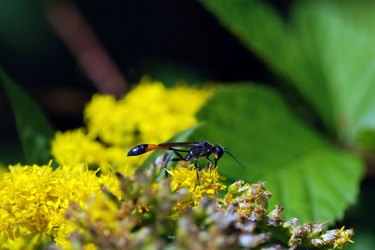
Several kinds of wasps inhabit Minnesota, sometimes close to homes. Although the term "wasp" may bring up images of painful stings and aggressive insects, most of the wasp species in Minnesota are not aggressive and serve as beneficial insects in the landscape.
Wasp Characteristics
Video of the Day
Wasps differ from bees not only in appearance but behavior. Physical characteristics of wasps include a narrow waist, slender body and cylindrical legs. Most kinds of wasps are shiny whereas bees tend to be robust and hairy.
Video of the Day
Some wasps are beneficial pollinators, as are bees. Unlike bees, though, most wasps are predatory creatures that feed on other arthropods. Many female wasps paralyze arthropods to feed them to their young.
Social Wasp Life Cycle
Social wasps, including yellowjackets (Paravespula spp.) and paper wasps (Polistes spp.), produce annual colonies in which every member except new queens die in autumn. Each fertilized queen overwinters in a protected area then rises in spring and builds a new nest and colony. The queen lays eggs in the nest's chambers, and small, grublike larvae hatch from the eggs. The queen feeds the larvae protein from insects or meat for about three weeks; the larvae then evolve into workers for the colony. The queen continues to lay eggs while the workers build onto the nest and feed the emerging larvae.
Because the workers die when the weather turns cold, control of wasps isn't necessary unless their nest is close to a home. In Minnesota, June is the best month to control a wasp colony in areas humans use. Wait until evening, when wasp activity is low, to deal with a hanging wasp nest; then, while wearing a hat, goggles and thick clothing that covers your skin, carefully cover the nest with a plastic bag and seal the bag shut. Cut down a large nest, or remove a small nest's by breaking the stem that attaches the nest to the surface from which it hangs. An option is to place the bag in a freezer to kill the wasps in a way considered more humane than leaving the bag elsewhere, but ensure the bag is sealed.
If your yard has an underground yellowjacket nest, then wait until a calm, non-windy night to pump a ready-to-use, carbaryl-based insecticide dust into the nest's entrance hole by using an insecticide duster. Dust insecticide is more effective than liquid insecticide because it more easily reaches a deep nest. Wear thick clothing to cover your skin, a hat, goggles and a dust mask to protect yourself from dust and stings.
Although most common wasps and all social wasps will sting, the majority of them are not readily aggressive and sting only when their nest is disturbed or humans get too close.
Yellowjacket Wasp
Yellowjackets are common sights in summertime in Minnesota as temperatures rise and wasp activity peaks. These yellow-and-black wasps live in social colonies and typically nest underground but sometimes have above-ground nests. In some cases, these semi-large wasps build their nests in walls of buildings. Like several other Minnesota wasps, they build papery nests.
The typical yellowjacket worker, the kind most commonly encountered, reaches about 1/2 inch in length and has alternating black and yellow bands. The queen is about 3/4 inch long.
Paper Wasp
The sight of a paper wasp nest is common in the state. The papery, brown, upside-down umbrella-shaped nest often hangs from an eave, railing and other horizontal surface. Different paper wasp species have different appearances, although their nests often can be used to identify them. Most of Minnesota's paper wasps are yellow and black but more slender than yellowjackets; others are reddish or brownish in color. They range from 5/8 to 3/4 inch long.
Bald-Faced Hornet
Bald-faced hornet (Dolichovespula maculata) is a wasp that reaches about 5/8 to 3/4 inch in length. It has distinctive markings; its body is primarily black with white or yellowish marks on its face and the tip of its abdomen.
This large hornet lives in a colony that builds a large, football-shaped, paper nest in a tree. The nest has an entrance hole that allows the colony's workers to enter and exit.
Sphecid Wasps
A large group of wasps known as sphecid wasps lives in Minnesota as well. These solitary wasps are often seen on the ground. Mud daubers belong to this group and are in more than one genera. Mud dauber species that are common in Minnesota include Sceliphron caementarium and Chalybion californicus. A mud dauber has a thin, long thorax, which is between its head and abdomen.
Sphecid wasps most often nest in the ground or in cavities, but some, including mud daubers, build mud nests on vertical surfaces. These wasps paralyze their prey and then carefully drag the victims back to their nests. Each species typically has a specific kind of prey; mud daubers prey on spiders.
Mud daubers and most other sphecid wasps are docile, non-aggressive unless handled carelessly. Controlling them is usually not necessary.